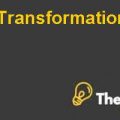
DUCTILE IRON CASE Solution
Question 1
Should the ductile iron return be shipped from the castings plants to the pipe-making plant? Yes, No, or Uncertain? Explain by identifying the assumptions that underlie your decision regarding shipping the ductile iron return. (Hint: Consider approaching the decision from an economic point of view)
Allentown is the pipe making plant and Pipe was produced in a different manner than the iron castings which are made at the other two plants. The process of pipe making yielded around 80% to 90% good pipe and the rest became the ductile iron return. Therefore, there was not much left for re-melting. However, historically the company had shipped the ductile iron return castings to the Allentown plant because the melting facilities at the Allentown plant had the capacity to accommodate the larger pieces of the ductile iron return.
Enough material was shipped previously which met the need for about 200 pounds which comprises of 4% of the total 5000 pound charge required in the production of the pipes at the Allentown plant. This totaled to a 16% of the ductile iron return for the pipe making charge as compared to the 40% to 50% ductile iron return from the castings charge. Moreover, the charges from pipe making could not contain more than 38% of the steel scrap due to high melt rate. Steep scrap was quite cheap as compared to the ductile iron returns. However, since the metallurgist at the pipe making plant has stated that the excess ductile iron returns from Pittsburg and Raccoon Creek plant could be substituted for the pig iron on a one on one basis.
Thus, this would minimize the production costs. Therefore, it is certain that the ductile iron return should be shipped from the Pittsburg and the Raccoon Creek plants. However, the fright charges must also be taken into account for each pound of the excess ductile iron return shipped to Allentown plant. The case states three possible methods for the valuation of the excess ductile iron returns which would be shipped to the Allentown plant. Calculations have been performed on the basis of each of these three methods based on certain assumptions.
The first method was to treat the ductile iron return as a by-product with no costs except for the freight costs. The excess castings from the Pittsburg plant are 4200 tons and from the Raccoon Creek plant are 1800. This is equal to total excess castings of 6000 tons which would be shipped. Under method 1, the material cost per ton would be $ 25 per ton which is only the cost of freight. This gives us a total castings cost per ton of $ 205.38 which is less than the original costs of $ 222.05 per ton as shown in exhibit 1. Under method 2, a market price of $ 175 per ton would be used for all the excess 6000 ton castings shipped to Allentown plant. This gives us a total castings cost per ton of $ 217.07 which is again less than the original costs of $ 222.05 per ton as shown in exhibit 2.
Finally, under the third method we have assumed that the castings cost per ton would be equal to the material manager’s valuation of the ductile iron return performed in exhibit 4 which is $ 194.91 plus the fright charges of $ 25 per ton. Based on the total castings cost for excess ductile iron return, the castings cost per ton for the Allentown plant has been calculated to be $220.57 as shown in exhibit 3. This is also lower than the original costs of $ 222.05 per ton. If we analyze the three methods from the cost/benefit point of view or economic point of view then method 1 gives us the lowest production costs for Allentown plant for the production of good pipe. Therefore, the ductile iron return should be shipped from the Pittsburg plant and the Raccoon Creek plant to the Allentown plant considering it as a by-product. Only the costs of freight should be paid by the Allentown plant........................]
This is just a sample partial case solution. Please place the order on the website to order your own originally done case solution.










